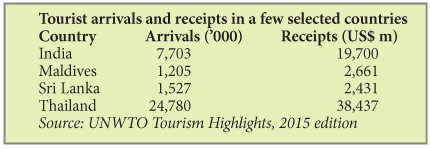|
Earnings from tourism:
SL below regional competitors
by Kanchana Wickramasinghe
This article on the theme 'World Tourism - One Billion Tourists, One
Billion Opportunities' was written to mark the World Tourism Day 2015
(which fell on September 27).
This year´s World Tourism Day highlighted the global potential of
tourism for socio-economic development.
 "With more than one billion international tourists now travelling
around the world each year, tourism has become a powerful and
transformative force which is making a genuine difference in the lives
of millions of people," said UN Secretary General Ban Ki-moon in a
message to mark World Tourism Day. "With more than one billion international tourists now travelling
around the world each year, tourism has become a powerful and
transformative force which is making a genuine difference in the lives
of millions of people," said UN Secretary General Ban Ki-moon in a
message to mark World Tourism Day.
With the tourism sector booming, the number of tourist arrivals to
Sri Lanka is expected to increase by 1.6 fold by 2016 to reach 2.5
million. While the South Asian region recorded a seven percent growth in
2014, Sri Lanka recorded a 20 percent growth in the number of arrivals.
The growth rates for India and the Maldives, two important
destinations in the region, were 11 and 7 percent, according to the
UNWTO 2015 Tourism Highlights. The growth rates in the number of tourist
arrivals in Sri Lanka shows that millions of tourist arrivals can create
'millions' of economic opportunities for the country.
Opportunities
Tourism can bring in economic opportunities, which can primarily or
secondarily contribute towards development. The real impact of tourism
on national output is hard to measure, given the complexity. Direct
economic opportunities come in the form of tourist spending. An array of
indirect opportunities is generated through the purchase of goods and
services from other sectors of the economy. Wage income in the industry
generates induced impact on the overall economy.
To increase the economic contribution of tourism, it is important to
pay attention to the indirect and induced impact in addition to direct
economic benefits. In Sri Lanka, the revenue generated through tourism
has been increasing following the revival of the tourism industry after
the end of the war in 2009. However, the country's earnings from tourism
are comparatively low when compared with regional competitors.
 In addition to foreign exchange earnings, tourism generated 129,790
direct and 170,100 indirect employment opportunities in 2014 according
SLTDA statistics. Employment in the industry accounted for 3.4 percent
of country's labour force in 2013. In addition to foreign exchange earnings, tourism generated 129,790
direct and 170,100 indirect employment opportunities in 2014 according
SLTDA statistics. Employment in the industry accounted for 3.4 percent
of country's labour force in 2013.
Around 80.4 percent of direct employment opportunities are in hotels
and restaurants. As highlighted in a recent ILO report and pointed out
by tourism experts, Sri Lanka's tourism industry is characterized by
significant skill gaps. A majority of those who join the sector either
possess relatively low quality technical and vocational education or are
trainees.
Soft skills
It is estimated that only 10 percent of the total employed in the
industry have undergone formal or informal technical and vocational
education and training. Significant soft skills improvement is necessary
in terms of English language, leadership, commitment, positive work
habits, creative and critical thinking.
Changes in the profiles of tourists at global and regional level can
also bring in numerous opportunities. China has now become one of thee
top ten source markets for Sri Lanka, according to the 2013 arrival
statistics of SLTDA. China contributes 4.3 percent of total tourist
arrivals in Sri Lanka. Rising disposable income, currency appreciation
and improved air connectivity have led to a significant increase in
Chinese outbound travel.
Spending by Chinese travellers has increased by 27 percent in 2013
when compared to 2012 and many destinations in Asia and Pacific are
benefitting from this development. To reap the benefits through the
China source market, Sri Lanka should strengthen strategies to attract
Chinese tourists.
Things to ponder
The macro level statistics do not often reveal the true picture of
tourism's role in promoting pro-poor development. It is acknowledged
that mass tourism does not generate major gains to local communities and
is characterized with high rates of outflows - termed as leaks. In
contrast, small scale community-based forms of tourism, where community
participation is considered as an integral element, can be more
beneficial for local communities. Sri Lanka, a destination rich with
natural and cultural endowments, has significant potential for
development of eco-tourism, agro-tourism and community tourism.
Such forms of tourism use local resources, whereby the level of
leakages is comparatively low. While a spectrum of tourism products are
required from small scale to mass scale, Sri Lanka should pay more
attention to developing the small scale tourism - which can perhaps be
niche markets - providing ample opportunities for local communities.
Sustainability
A number of opportunities can also be created through effective
promotion of business tourism and Meetings, Incentives, Conferences and
Exhibition (MICE) tourism in Sri Lanka. The sustainability of the
tourism industry is strongly linked with environmental and
socio-cultural aspects of a destination. Tourism can be used as a tool
to raise awareness and contribute towards preservation of natural and
cultural assets.
For instance, eco-tourism can be used as a sustainable tool in
natural forest management, as highlighted in an IPS study.
Tourism development in the identified regions also call for careful
consideration. Infrastructure development in regard to tourism should
not only consider the direct economic gains, rather, special attention
should be paid to socio-economic and environmental implications of the
respective areas.
Given the opportunities stemming from tourism, there have been
transformations from existing livelihoods to tourism related
livelihoods. "People here find tourism a more lucrative business than
engaging in fisheries," said a villager from Kandakuliya, Kudawa - a
village under transformation from fisheries to tourism in the Kalpitiya
tourism area.
"However, there are significant threats to mangroves due to ongoing
tourism development", he said.
Assurance of environmental and social sustainability should be an
integral part of tourism development, from the initial stages, for a
healthy growth in the industry.
Sri Lanka has a strong positive outlook if tourism development is
undertaken carefully. There is much to be done in harnessing Sri Lanka's
full range of opportunities in tourism, and the country should not miss
or postpone making use of these opportunities.
The writer is a Research Economist at the Institute of Policy
Studies. |

